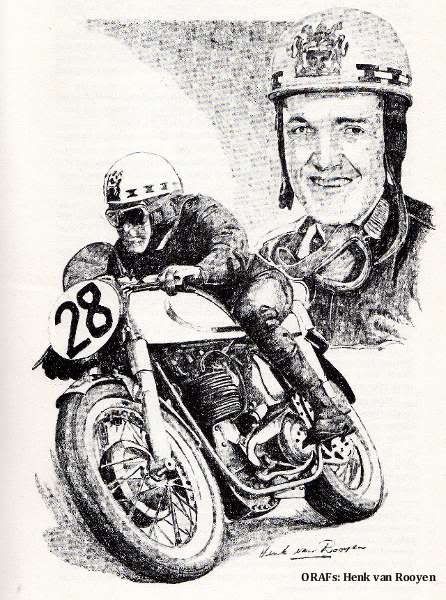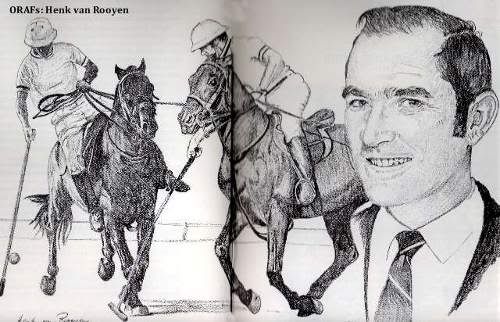William Raymond Amm
"Amm killed by skid in Italian motor cycle gold cup race" — that was the front-page headline in the Rhodesia Herald on 12 April 1955. which stunned the nation.
For Ray Amm, a fearless rider who put the country's name at the forefront of the sporting world, was truly one of Rhodesia's most famous sons.
The fateful day was 11 April 1955, at Imola, when Amm's 350 cc four- cylinder MV Augusta, in second place, skidded and crashed into a steel standard on the 22nd lap of the Italian Gold Cup.
Eye witnesses said that at first it appeared that he was in control of his machine as it skidded, but he careered into the pole and was rushed to hospital, where he died twenty minutes later.Amm was just twenty-seven and it was his first race for the famous Italian MV firm, though he was already known and respected throughout the racing world for his expertise as the number one works rider for British Norton. In just four years on the overseas circuit he had built a record of spectacular successes and wasacknowledged as one of the worlds leading Grand Prix riders.
He was never a world champion, though he was the first Rhodesian to venture to Europe and he sparked the country's remarkable record in international motor cycling — an incredible eight world titles between Gary Hocking (2) and Jim Redman (6).
News of Amm's death brought widespread grief. At Imola a crowd of about 1 000 gathered at the hospital for the procession which took the body to a candlelit chapel, where ten motor cycle mechanics, in blue overalls, kept vigil all night.
Thousands of people lined the streets of Imola in silent tribute when Amm's body left by car for Rome, from where it was flown to his beloved Rhodesia for burial.
People of all ages and races mourned at Amm's funeral, illustrating his immense popularity. The Salisbury Baptist Church was packed and scores stood outside in tribute. The service was relayed to the streets by loudspeakers and the Rev. Sidney Hudson-Reed said: "He earned national and international honoursand procured a multitude of friends and admirers." We are gathered to recognise the honour which Ray Amm has brought to his country, not only in his achievements but much more in the manner of his achieving them."
Amm's most notable triumphs came in 1953 at the rugged and mountainous Isle of Man — the toughest test on two wheels — where he won both the Senior (500 cc) and Junior (350 cc) world championship Tourist Trophy races.
Not only was he the first overseas rider to win an international TT, but in making it a double he accomplished a feat achieved by only four other riders at that time. They were P. Hunt (1931), S. Woods (1932 and 1933), A. Guthrie (1934) and the famous Geoff Duke (1951). Like Amm, all four had been mounted on Nortons.
Amm's average speeds of 93,85 mph (Senior) and 90,52 mph (Junior) broke Duke's TT records of 1951 and 1952 respectively, while at the time of his death the Rhodesian held the Isle of Man TT lap record of 97,41 mph.
He crowned his 1953 successes by winning the 350 cc and 500 cc internationals at a major meeting in Rio de Janeiro.
In 1952 Amm had won the Grand Prix of Nations for Norton, while in 1954 he took the chequered flag first in the Ulster Grand Prix and the German Grand Prix, finishing runner up that year to Duke in the 500 cc class and to Fergus Anderson in the 350 cc class of the world championships.
William Raymond Amm was born at Salisbury on 10 December 1927, and was educated at Prince Edward School. He started racing in 1946 at the age of nineteen and was schooled on the oiled-dirt surfaces of Coro Park in Salisbury, and Umgusa Speedway in Bulawayo. Among the riders of his day were Charlie Harrison, Phil Snyman, Colin Graves, Hymie Stanger, Jack Riley, and John Love who was then on bikes.
Riding a second-hand AJS which had cost him £90 Amm fell off five times in his first race, coming last. Despite this it was clear to the experts that 'Ammy had real class and the next season he bought and hotted-up a 500 cc Norton, and proceeded to break the lap records on every track in the country, in only his second year.
In 1948 he borrowed £300 from his grandmother and bought his first new Norton. He entered the gruelling Port Elizabeth 200 — the most severe test in South Africa — and came seventeenth. But he broke the lap record and people were taking notice of him.
He was invited to the prestigious Isle of Man meeting in 1949, but was unable to go, choosing instead to stay at home to marry his childhood sweetheart Jill Patton on 3 December 1949. The eighteen-year-old Salisbury girl was a keen motor cycle follower.
By now he was Rhodesia's leading rider and in 1950 again tackled the PE 200. This time, starting as scratch man, he came third and again broke the lap record. In the same year he bought another Norton and immediately broke the Coro Park lap record with a time of 1 min. 4,6 sec.
Another invitation to the Isle of Man followed and with a £100 grant from the Salisbury Motor Cycle Club, Amm sold his car and almost all his personal possessions, and in 1951 headed for adventure in England. Travelling with his wife in a caravan in England, he had enough money to buy two Nortons' and he entered both the Senior and Junior TTs, finishing ninth and twenty eighth — a good start on private machines against the world's crack riders and 'works' machines. During the whole season, his wife Jill — an experienced motorcyclist herself — acted as timekeeper.
Amm won the Swiss Grand Prix in 1951 and, just a year after his European debut, he was given a place in the Norton team alongside the great Geoff Duke in 1952. A year later when Duke turned to cars (he later switched back to bikes Gilera) Amm was made Norton team-leader.
He spent four months in Ireland helping to design and build the new streamlined Norton, two of which were made for him to his own specifications. In 1953, Amm agreed to accept a fee of £1 500 a year to ride for Norton, and promptly enhanced his own and the manufacturer's prestige by winning both major TT events.
He might well have repeated this feat in 1954. but after a clear-cut win in the Senior TT, he withdrew from the Junior event because of a mechanical fault
In the 1954 prestige Ulster Grand Prix, Amm defied wind and rain to record a distinction only once before achieved — he won both the 350 cc and 500 cc races. For his week's riding and for the TT races a fortnight earlier, he earned £500, plus expenses, on top of his salary from Norton.
The Rhodesian considered the undulating Manx circuit at the Isle of Man as the toughest in the world. "It is the supreme test for man and machine," he said. Ray Amm's attributes were a keen eye, split-second judgement and nerves of steel. In fact as a youngster he was often criticised for being 'too wild and daredevil'. He was, perhaps, overbold and aggressive at times and prone to gamble with his luck, but he matured into one of the world's great bikemen.
When he was criticised in England for his 'grass track style of riding' and for overplaying the use of his feet when cornering (a style which he proved to be successful), Amm quipped: "I grew up in the saddle . . . and a horse wasn't under it"
Amm's meteoric rise to fame overseas was proof that he was a brilliant rider. In the postwar 'gold rush' for motor cycle talent, the Rhodesian was one of the most shiny nuggets.
Rhodesia's first truly internationally known sportsman, Amm left Norton at the end of 1954 to attempt to become world champion on the powerful scarlet Italian MV Augustas. The Italian factories of MV, Gilera and Moto Guzzi had by 1953 ended Britain's half-century lead in motor cycling, and the championship hopes of individuals now lay with these potent machines.
But Amm's ambition was to end in tragedy at Imola at the outset of his challenge. On his death — Amm's parents heard about it on a BBC news broadcast — a tribute in the Belfast Telegraph said: "His fearless yet confident style of riding appealed to countless thousands. He was regarded as one of the most brilliant riders ever discovered by Ulsterman Joe Craig of Norton."
Until his death, Amm had only suffered two serious injuries on the track. He crashed in the German Grand Prix 'Solitude' near Stuttgart in 1953 and spent a month in hospital there with a back injury. And he crashed at Aintree, England, in 1954 and spent about a month recuperating at Geoff Duke's house at Southport near Liverpool. In 1952 Amm broke a leg, though this did not prevent him from riding in the Italian Grand Prix and winning it. . . with his leg in plaster.
A granite memorial, at first placed near the Coro Park track where he started his career, is now at Sable Comer of Salisbury's Donnybrook Park race-track. Here the name of a great Rhodesian,Ray Amm, is perpetuated.
- BYROM
End
Labels: motor cycle racing, William Raymond Amm





